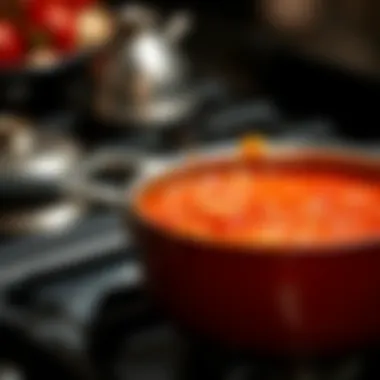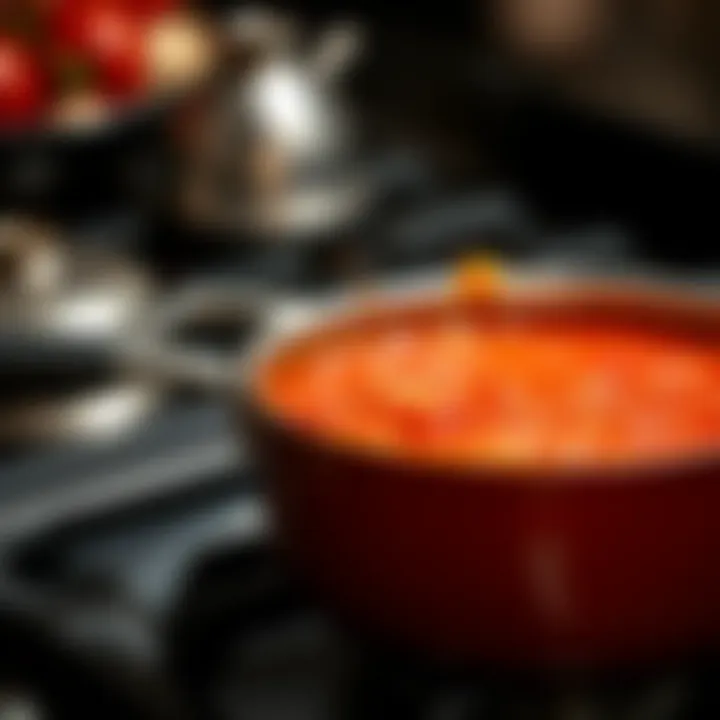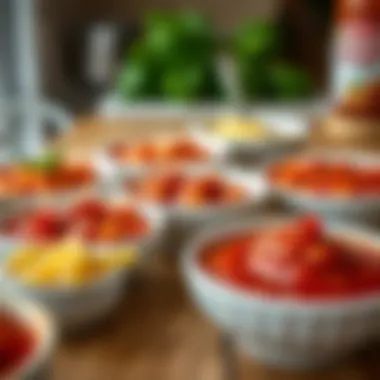Craft Your Perfect Prego Pasta Sauce at Home


Intro
Pasta sauce, especially a hearty tomato-based one, is more than just a meal accompaniment; it's a canvas for culinary creativity that’s been embraced in homes around the world. This guide aims to shed light on crafting a homemade version of Prego pasta sauce, an iconic staple that can elevate your pasta dishes! From the fundamental ingredients to the cooking techniques, and seasoning variations that awaken the flavors, each step will serve to deepen your appreciation for making sauces from scratch.
Cooking may seem like a chore for some; however, the rise in popularity of homemade sauces has sparked a renewed interest among food enthusiasts. Imagine the satisfaction of using wholesome ingredients to create something distinctly personal, tailored to your palate. As we journey through the nuances of this go-to sauce, keep in mind that your kitchen is where the magic happens. So, let’s roll up those sleeves and get down to work!
Ingredients Breakdown
Understanding the components that make up Prego pasta sauce is crucial to replicating its iconic taste.
Primary Ingredients
To kick things off, let’s highlight the essentials that are non-negotiable for a classic tomato sauce:
- Tomatoes: The star of the show, preferably crushed or diced.
- Olive Oil: A splash to create that rich mouthfeel and flavor.
- Garlic: Minced, for depth and aroma.
- Onion: Chopped, offering a subtle sweetness.
- Salt and Pepper: Basic yet vital seasonings to taste.
Optional Ingredients
If you’d like to take the flavor wheels a notch higher, consider including these:
- Oregano and Basil: Classic herbs that blend seamlessly with tomatoes.
- Sugar: A pinch can tame the acidity of the tomatoes.
- Parmesan Cheese: For a creamy finish, a grated sprinkle works wonders.
- Red Wine: A splash can add complexity.
Essential Kitchen Tools
Having the right tools can make the process smoother:
- Heavy-bottomed Pot: For even heat distribution.
- Wooden Spoon: To stir and prevent sticking.
- Blender or Food Processor: If you prefer a smoother texture.
- Measuring Cups and Spoons: Precision is key in cooking.
Step-by-Step Preparation
Now, let’s break down the process into manageable steps that ensure a robust sauce.
Prepping the Ingredients
Start by chopping onions and mincing garlic. The goal is to prepare everything beforehand to render cooking seamless. Don’t forget to drain any canned tomatoes, if you're using them, to avoid excess juiciness.
Cooking Techniques and Methods
In a heavy pot, heat olive oil over medium heat. Add the chopped onions first, cooking until they become translucent. This usually takes about 2-3 minutes. Then, toss in the minced garlic for another minute, ensuring it doesn’t burn, as that can add undesired bitterness. Next, mix in your tomatoes and let the concoction simmer. Stir occasionally, and don’t rush this step; patience is a key ingredient!
Assembly and Presentation Tips
Once the sauce thickens to your liking, taste it and adjust seasonings. Consider pairing it with your preferred pasta, whether it's a long strand like spaghetti or a short variety like penne. When serving, a drizzle of olive oil and a sprinkle of grated Parmesan can make a world of difference.
Dietary Considerations
Catering to various diets can extend the sauce's reach, ensuring that everyone at the table enjoys a portion.
Gluten-Free Options
If pasta is to be gluten-free, options like brown rice or chickpea-based pasta serve well without sacrificing satisfaction.
Vegetarian and Vegan Substitutes
For a plant-based twist, simply omit cheese and make sure all ingredients are without animal by-products. Nutritional yeast can be an excellent replacement for that cheesy flavor.
Nutrition Facts & Nutritional Considerations
Homemade sauces like this often cut down on artificial preservatives and high sugar content. When you use fresh or organic tomatoes, you’re also boosting nutritional benefits such as vitamins A and C.
Variations and Customizations
Once the foundational sauce is mastered, there’s room for adaptation.
Flavor Enhancements
Experiment with adding chili flakes for heat, or if you fancy something unique, a splash of balsamic vinegar can bring a delightful tang.
Alternative Cooking Methods
The sauce can also be slow-cooked for an even richer flavor profile. Just toss the ingredients in a slow cooker and let it do its thing.
Pairing Suggestions (Sides, Drinks, etc.)
Pasta pairs wonderfully with garlic bread or a fresh side salad. For drinks, a light red wine can complement the sauce beautifully.
Common Answers to Common Questionss and Troubleshooting
As with any cooking endeavor, questions might spring to mind:
Frequently Asked Questions
What if my sauce is too watery? Simmer it longer without a lid to reduce excess liquid.
Can I freeze leftover sauce?
Absolutely! Just allow it to cool before transferring to airtight containers.
Common Mistakes to Avoid


It’s easy to get carried away with seasoning. Always taste as you go to ensure balance.
Solutions to Potential Problems
If the sauce turns out too sour, a small amount of sugar can help counterbalance it.
Crafting pasta sauce from scratch is not only gratifying but also a way to personalize a beloved staple. Each ingredient can tell a story, and the flavors can adapt to your culinary journey.
Preface to Prego Pasta Sauce
In the culinary landscape, few things evoke warmth and nostalgia quite like a rich, savory pasta sauce. Among the many options available today, Prego pasta sauce stands out for its convenience and versatility. Making your own at home not only allows you to customize flavors to your liking but helps you reconnect with cooking as a joyful act rather than a chore.
A homemade Prego sauce isn’t just about tossing ingredients into a pot; it’s about elevating your pasta dishes to new heights. This section highlights key elements that will be explored throughout the article, such as understanding core components, unraveling the significance of crafting your own sauce, and discovering how to transform basic ingredients into something extraordinary for your next meal.
Understanding the Basics of Pasta Sauce
When talking about pasta sauce, it’s crucial to understand its essence. At its core, pasta sauce is typically tomato-based, but there’s a plethora of ways to jazz it up. For starters, the foundation can vary: some cookers prefer a sauce that’s smooth and sweet while others might lean towards a chunky and tangy variant. The key to a good sauce lies in balance; acidity from the tomatoes should be countered with sweetness – perhaps from carrots or a dash of sugar.
Moreover, choosing high-quality tomatoes—like San Marzano ones—can make a significant impact on flavor. Processing these tomatoes in unique ways, whether crushed, diced, or pureed, can also alter the sauce’s texture and taste. Always remember, the magic is in the details, be it opting for fresh herbs over dried or adjusting seasoning layers as per personal preference.
The Significance of Homemade Sauce
Homemade sauce brings a sense of accomplishment and creativity to the kitchen. While store-bought options like Prego provide a quick solution, crafting your own allows for unique adaptations. Beyond just taste, making your sauce can be a healthier alternative, enabling you to control sodium content and avoid preservatives that lurk in commercial counterparts. With a glance at how simple ingredients can come together to create complex flavors, anyone can appreciate the beauty of homemade sauce.
Furthermore, there’s a deep-rooted cultural importance tied to cooking pasta sauce from scratch. It evokes traditions passed down through generations and invites experimentation. Whether for family gatherings, intimate dinners, or just a busy weeknight, the act of cooking fosters a connection to those who came before us while building our culinary identity.
"The sauce you create is more than just a meal; it’s a reflection of your palate and heritage."
In summary, diving into the world of homemade Prego pasta sauce isn’t just a task; it’s an exploration deeply intertwined with traditions and personal tastes. Through understanding basic concepts and recognizing the significance of crafting sauce, home cooks can find joy in every step of the process.
Essential Ingredients for Prego Pasta Sauce
Creating a homemade Prego pasta sauce isn't just about following a recipe; it's about understanding how each ingredient contributes to the final dish's flavor profile. Each component plays a crucial role in building layers of taste and texture, elevating the sauce from simple to sensational. When you choose the right ingredients, you not only enhance the flavor but also ensure that the sauce is wholesome and satisfying.
Tomatoes: The Heart of the Sauce
Tomatoes are the backbone of any pasta sauce, and this holds especially true for Prego. Whether you're using fresh plum tomatoes or opting for the convenience of canned varieties, what matters most is the quality. Vine-ripened tomatoes, for example, bring a balance of sweetness and acidity, essential for a rich sauce. Alternatively, San Marzano tomatoes are a favorite among chefs for their low acidity and robust flavor.
Tip: Always taste your tomatoes before incorporating them. A good tomato can make or break your sauce.
A key consideration when using tomatoes is the cooking method. For a thicker sauce, consider roasting or sautéing them first to caramelize and deepen their flavor. If you're looking to keep it simple, simply crush the canned ones and cook them down to reach your desired consistency.
Herbs and Spices: Adding Depth
Next, we delve into herbs and spices, the magic wands that can turn a bland sauce into a bowl of perfection. Basil is a classic choice, lending a fragrant touch, while oregano offers an earthy note. Don't forget about red pepper flakes if you want to introduce a hint of heat. The timing of adding these herbs is equally important; dried herbs release their flavors slowly, making them ideal for simmering early in the cooking process. Fresh herbs, on the other hand, should be added towards the end for a vibrant punch.
When incorporating spices, a pinch of sugar can work wonders to counteract acidity, making the overall dish more balanced. Remember, the goal is to create a harmony of flavors that compliments the tomatoes, rather than overpowering them.
Onions and Garlic: Building Flavor
No pasta sauce is complete without the warm, aromatic embrace of onions and garlic. Onions provide a natural sweetness that complements the acidity of the tomatoes, while garlic adds depth and complexity. A good rule of thumb is to sauté them together in olive oil until they’re golden brown; this brings out their natural sugars and creates a solid foundation for the sauce.
You might want to experiment with different onion varieties as well. For example, yellow onions give a robust flavor profile, whereas shallots offer a milder, more delicate sweetness. Regarding garlic, choose fresh cloves over pre-minced options for a more potent and fragrant taste.
The golden rule here is to respect the cooking time of these ingredients. Rushing them through high heat might scorch them, resulting in bitterness in your sauce. Careful attention to the development of flavors is what separates a good sauce from a great one.
In summary, the essential ingredients of tomatoes, herbs, spices, onions, and garlic serve as the building blocks for your Prego-style sauce. By choosing quality ingredients and understanding their roles in the cooking process, you set the stage for a truly outstanding dish that speaks to the heart of Italian cuisine.
Step-by-Step Preparation of Prego Pasta Sauce
When it comes to making a remarkable Prego pasta sauce, understanding the step-by-step preparation process is essential. Each phase builds on the last, creating layers of flavor and enhancing the overall dish. This guide breaks it down clearly, ensuring that anyone can follow along and produce a delightful homemade sauce.
Gathering Your Ingredients
Gathering all the ingredients before diving into cooking can make a world of difference. It saves time and stress during the actual cooking process. You want to make sure you have every single item ready, so everything flows smoothly. Picture this: you’re halfway through making your sauce, and then realize you forgot to buy onions. Not fun, right?
Some of the core components you'll want to have on hand include:
- Fresh or canned tomatoes
- Olive oil
- Garlic
- Fresh herbs like basil and oregano
- Onion
- Salt and pepper
Having a well-stocked pantry can help when inspiration strikes, so keep these essentials handy. Also, consider any additional ingredients you may want to add based on personal preferences or dietary needs.
Chopping and Prepping: The Foundation
Chopping and prepping your ingredients is like setting the stage for a play. Each piece needs to be just right for the main event to shine. This task might feel mundane, but it’s crucial. Start by finely dicing onions and garlic. Don’t forget to chop fresh herbs too; they will contribute significant flavor.
You want to make sure your ingredients are uniform in size to ensure even cooking. The aroma when you start sautéing these freshly chopped ingredients will make your kitchen smell divine, attaching that warm, homey feeling to your cooking experience.
Cooking Process: Methodical Layers
Cooking your sauce in layers helps to develop a depth of flavor that can be lacking if all the ingredients are tossed in at once. This methodical approach not only keeps things organized but also allows each ingredient to shine on its own before melding together into your finished product.
Sauteing the base ingredients
Sauteing your base ingredients—onions, garlic, and possibly some carrots—creates a flavor explosion right from the start. The key characteristic of this step is that it allows the natural sugars in the onions to caramelize, enhancing their sweetness, which offsets the acidity of the tomatoes.
This method is popular for a good reason; it lays a robust foundation for your sauce. By heating the olive oil before adding these ingredients, you activate the oil's flavors and help lock in the aromas, giving your sauce that homemade touch. However, it is crucial not to burn these ingredients; burnt garlic can ruin your sauce.


Simmering for flavor infusion
The simmering stage is where your sauce truly transforms. This step allows flavors to mingle and deepen. After adding the tomatoes and herbs to your sautéed ingredients, turning the heat to low encourages a slow, gentle bubbling. It’s like giving your ingredients time to tell their stories together.
This method is beneficial, as it extracts more flavor from your ingredients and allows spice combinations to bloom. Letting the sauce simmer for at least 30 minutes will yield better results than a quick cook. On the flip side, too much simmering can lead to a thicker sauce than some might prefer. Therefore, keeping an eye on the texture is paramount.
Adjusting texture and seasoning
Adjusting the texture and seasoning of your sauce is where the cooking becomes personal. This step is much like tailoring a suit; you want it to fit just right. Adding water or broth can help reach your desired thickness, depending on whether you favor a heartier or lighter sauce.
Stick to the principle of balance in flavor—have the right amount of salt and pepper, and perhaps a touch of sugar if the sauce feels too acidic. Engaging in this tailoring process allows you to create a sauce that not only meets your standard but perhaps even exceeds expectations.
Quick Tip: As you taste and adjust, keep in mind that flavors will develop as the sauce continues to cook and settle.
In the end, taking each of these steps carefully can transform a simple set of ingredients into a delightful homemade Prego sauce, ready to elevate any pasta dish. This methodical approach will have you on your way to serving up a sumptuous sauce that feels both familiar and uniquely yours.
Variations on Traditional Prego Sauce Recipes
When it comes to sauce making, creativity opens many doors. There’s little doubt that Prego pasta sauce has earned its place on countless dinner tables, yet the beauty of culinary arts lies in the variations one can experiment with. Adjusting basic recipes allows for a wealth of flavors, textures, and nutrient enhancements suitable for diverse palates. The possibilities are boundaries waiting to be blurred, and each variation can cater to specific dietary needs or personal preferences.
Adding Meat: Bolognese Style
If you fancy a hearty meal, consider going the Bolognese route. This variant typically incorporates ground beef or pork, delivering a richness that complements the acidity of the tomatoes. The meat adds not just flavor but also protein, making it a complete meal.
One approach might look like this:
- Choose Your Meat: Ground beef works well, but you could also use turkey for a leaner option.
- Cook It Right: First, sauté the ground meat until browned. Once you’ve set it aside to drain, start your traditional tomato-based sauce and reintroduce the meat during the simmering phase. This ensures the earthy flavor permeates the entire dish.
- Add Depth: Don’t skimp on connecting flavors. Toss in some diced carrots and celery, along with your onions and garlic, for a well-rounded profile.
Classic Bolognese isn’t just about throwing in meat; it’s about understanding and evolving the culinary narrative.
Vegetarian Options: Emphasizing Freshness
In response to the growing demand for vegetarian meals, crafting a vegetarian version of Prego sauce can be both exhilarating and satisfying. Utilize fresh seasonal vegetables that speak to the palate all year round.
- Base Ingredients: Begin with your classic garlic and onions. Next, add chopped bell peppers, zucchini, or mushrooms—these provide texture and additional nutrients.
- Herbal Enhancements: Trying fresh herbs like basil, oregano, and thyme elevates the dish. A touch of balsamic vinegar can also enhance the flavors while staying vegetarian.
- Consider Add-Ins: Lentils or chickpeas bring in fiber and protein, fitting right into the vegetarian ethos without sacrificing heartiness.
This variant celebrates seasonal yields, offering not just a meal but a mindful approach to sourcing ingredients.
Spicy Additions: For the Bold Palate
If you're one who's always reaching for the hot sauce, there’s no reason why your pasta sauce can’t echo that love for spice. This variation can set your dishes apart with an exciting kick that partners beautifully with rich pasta.
- Heat Sources: Options abound from crushed red pepper flakes to chopped jalapeños or even a splash of sriracha. Each choice will forge a distinct path in terms of flavor and heat intensity.
- Pair with Sweetness: Balancing heat with sweetness can enhance the experience. A hint of brown sugar or diced bell pepper may do the trick, creating a symphony of flavors.
- Garnish Wisely: Top your dish with fresh cilantro or scallions to add a fresh note, effectively taming the fire while maintaining that sense of adventure in every bite.
This spicy variation not only satiates cravings for heat but ensures each serving is anything but ordinary.
Serving Suggestions for Prego Pasta Sauce
Understanding how to serve your homemade Prego pasta sauce is crucial to bringing out its full potential. While pasta is the obvious choice, there’s a wealth of options that elevate the dining experience, allowing you to explore your culinary creativity. The right serving suggestions not only enhance the flavors of the sauce but also open up avenues for creating dishes that can please any palate. Here, we dissect various pairing options, moving between classic combinations and inventive adaptations.
Pairing with Pasta: A Culinary Classic
Pasta and sauce have stood the test of time as a beloved pair in kitchens around the globe. When it comes to Prego pasta sauce, selecting the right pasta type can profoundly influence the dining experience. Long strands like spaghetti elegantly twirl around forks, capturing each bit of rich tomato flavor, while tube-shaped varieties like penne or rigatoni catch the sauce within their curves, resulting in a hearty bite.
One of the standout reasons for this pairing is texture balance. The sauce's thickness complements the surface area of pasta, creating a delightful mouthfeel. Additionally, cooking the pasta al dente allows for a little bite, which pairs beautifully with the sauce's warmth. All in all, defining pairings like these set the stage for a fulfilling meal that can impress the crowd, or simply satisfy your personal cravings.
Incorporating into Other Dishes: Beyond Pasta
Prego pasta sauce isn't just for pasta; it's a versatile element that can adapt to fit various dishes beyond the classic Italian fare. Here are two inventive routes you can take:
Using as a pizza sauce
Utilizing Prego pasta sauce as a pizza base brings convenience and flavor together. This approach allows for a quick yet fulfilling meal when you lack the time or ingredients to make sauce from scratch. The inherent tomato goodness becomes a fantastic foundation for pizza creation.
When using it, consider its rich and savory flavors that can be accentuated with toppings. A sprinkle of mozzarella cheese paired with your favorite vegetables or meats can truly transform a simple pizza night into a culinary event. Moreover, the ease of spreading the sauce onto dough appeals to novice cooks and seasoned chefs alike, assuring a delicious homemade pizza without the fuss.
Transforming into casseroles
Casseroles offer a comforting, one-dish option that many appreciate. Incorporating Prego pasta sauce into casseroles not only adds moisture but also layers of flavor that develop through the cooking process. The sauce enriches other components like vegetables, meats, and pasta within, creating a cohesive dish.
The ability to mix and match ingredients means that you can get creative, adjusting to seasonal produce or what’s on hand. The sauce's acidity also helps balance richer items, ensuring the dish remains vibrant and appealing. However, it's wise to remember that too much sauce could make the casserole excessively soggy, so precision is key.
Storage and Preservation of Prego Sauce
When it comes to enjoying Prego pasta sauce, knowing how to properly store and preserve it is just as crucial as the preparation itself. A well-stored sauce not only retains its flavor but also ensures that it remains safe for consumption. In this section, we will delve into the best practices for refrigeration and explore freezing techniques that can extend the shelf life of your homemade masterpiece.
Best Practices for Refrigeration
Refrigeration is typically the first line of defense against spoilage. After you've cooked up a batch of your flavorful sauce, allowing it to cool before storage is vital. Placing a hot sauce directly into the fridge can raise the internal temperature of the appliance, potentially leading to unsafe conditions for other stored foods.
- Cool Quickly: You can hasten the cooling process by placing the sauce in a shallow container. This increases the surface area and promotes even cooling.
- Sealed Containers: Store the sauce in airtight containers. Glass jars or BPA-free plastic containers work well, as they prevent air from spoiling the flavor and texture.
- Label and Date: Don’t forget to label your containers with the date. Prego sauce can keep well in the refrigerator for about 5 to 7 days, but it’s best to consume it sooner for optimal taste.
Remember that fresh sauce tastes best. It's your homemade delight, so enjoy it while it’s still at its prime!
Freezing Techniques for Long-Term Use
Freezing is a smart option if you want to store Prego sauce for several months. The freezing process halts bacterial growth, preserving the integrity of the flavors you painstakingly crafted. Here’s how you can freeze your sauce effectively.


Containers and bags for freezing
When it comes to containers for freezing, you have two primary choices: airtight freezer containers or heavy-duty freezer bags. Each has its own merits.
- Airtight Freezer Containers: These provide excellent protection against freezer burn. They come in various sizes, making them great for bulk batches or single servings. Look for ones with leak-proof seals to avoid any nasty spills.
- Heavy-Duty Freezer Bags: These bags are a popular choice for freezing sauces due to their ability to conform to the shape of the sauce, making for more efficient use of space. Simply pour the cooled sauce into the bag, remove excess air, and seal. They are also easier to stack in the freezer compared to rigid containers. However, pay attention to the quality as not all bags are equal in terms of insulation.
Both options have their unique features and benefits. If you prefer an organized freezing approach, containers might be your go-to, whereas bags are great for saving space.
Defrosting methods
Defrosting your frozen Prego sauce is just as important as how you freeze it. The method you choose can impact both flavor and texture. Here are a few methods:
- Refrigerator Thawing: This is the recommended method. Place the frozen sauce in the fridge overnight. It’s a safe way to thaw, but you’ll need to plan ahead. This method keeps the sauce from being exposed to temperatures that may cause bacterial growth.
- Cold Water Bath: If you’re in a pinch, seal the bag tightly and submerge it in cold water. Change the water every 30 minutes to ensure it thaws evenly.
- Microwave: While quick, this method can lead to uneven heating, which may result in hot spots and a change in texture. If you opt for this, use the defrost setting and give the sauce a stir halfway through.
Each method has its plus and minus points, but keeping food safety in mind is always priority number one. With these storage tips, you can savor your homemade Prego sauce long after it’s been cooked.
Common Mistakes in Sauce Preparation
Preparing pasta sauce, especially one that resembles the well-loved Prego variety, can seem like a straightforward affair. However, there are common pitfalls that can turn a potential culinary triumph into an average meal. Making pasta sauce is an art, and understanding these mistakes can elevate the quality and enjoyment of your homemade creation. By recognizing and avoiding these blunders, you can ensure each pot of sauce is flavorful, balanced, and worthy of being served to family and friends.
Overcooking or Undercooking
Cooking pasta sauce requires a delicate balance of time and temperature. Overcooking the sauce is a frequent error; it can lead to a dull flavor profile as the tomatoes break down too much, losing their fresh taste. Conversely, undercooking can result in a harsh, unblended mixture that lacks the depth or richness you expect from a hearty sauce.
A key point to remember is that tomatoes need time to meld flavors but not so much that they lose their body. Stirring occasionally allows the sauce to cook evenly, ensuring no part burns. For novices in the kitchen, a helpful tip is to use a timer, checking the sauce every few minutes once it reaches a simmer. This practice helps.
- Signs of Overcooking:
- Signs of Undercooking:
- Sauce becomes excessively thick.
- A charred smell arises during cooking.
• - The vibrant red color of tomatoes fades to a lackluster brown.
- Raw, acidic taste lingers on the palate.
- Texture feels chunky or abrasive rather than smooth.
- Ingredients seem distinct rather than blended.
This balance not only optimizes flavor but also improves overall texture, making it appealing on the plate. An excellent approach is to follow a trusted recipe but rely on your senses—taste and smell play critical roles in the overall outcome.
Misapplying Seasoning
When it comes to pasta sauce, seasoning is the secret weapon that can make or break it. A common mistake is either over-salting or under-seasoning the sauce. Too much salt can result in a dish that feels harsh and unappetizing, often overwhelming the freshness of the tomatoes. On the other hand, not enough seasoning may leave the sauce flat and uninspired, lacking its potential depth.
A well-seasoned sauce builds character and enhances the overall experience, creating harmony with other ingredients. Fresh herbs traditionally do wonders and should be added at the right time—dried herbs should be added early in the cooking process, while fresh herbs should be stirred in at the end to maintain their aroma.
- Common Missteps in Seasoning:
- Adding salt before tasting can falsely alter perceived flavor.
- Forgetting the balance of acidity and sweetness in tomatoes.
Addressing seasoning doesn’t just involve salt. Balancing acidity with ingredients like sugar can bring forth the natural sweetness of tomatoes, enhancing flavors rather than masking them.
Good seasoning is the soul of a great sauce. If you get this right, everything else follows.
Overall, avoiding common mistakes in sauce preparation can have a monumental impact on your dish. Mastery comes from practice but also being considerate of the ingredients, their needs, and how best to bring them together. Your taste buds will thank you.
Cultural Context and History of Pasta Sauce
The appreciation for pasta sauce, particularly tomato sauce, extends beyond its flavor profile. Understanding the history and cultural ramifications associated with this beloved condiment reveals how deeply ingrained it is in various culinary traditions. As we dive into the narrative, we’ll discover the tapestry of influences shaping homemade sauces today.
Tracing the Origins of Tomato Sauce
Tomato sauce, now a staple in many kitchens, boasts a fascinating history. Although one might assume the tomato was always the star of the show, its journey began after its introduction to Europe from the Americas in the 16th century. Initially, tomatoes were met with suspicion. Some even believed they were poisonous. Over time, however, the humble tomato overcame cultural biases and began carving out its place in European cuisine.
Early versions of tomato sauce were quite different from what we enjoy today. At first, it was the Italians who embraced tomatoes, cooking them with herbs and spices to create something scrumptious. It replaced older sauces that were typically meat-based. Recipes blossomed across regions, resulting in diverse interpretations that still honor the core ingredient.
The pivotal moment came in the late 19th century when Italian immigrants brought tomato sauce to America. By then, it had evolved into a richer blend of tomatoes, herbs, and garlic, appealing to a growing palette eager for vibrant flavors. This era marked the transformation of tomato sauce from a mere ingredient to a culinary staple.
Culinary Evolution Across Regions
The evolution of pasta sauce, particularly tomato-based varieties, diverged significantly across different cultures. In Italy, each region has its take on pasta sauce utilizing local ingredients. For instance, in Naples, the famous Marinara sauce captures simplicity with tomatoes, garlic, olive oil, and herbs. Meanwhile, in the north, cream-based sauces are more common, reflecting regional dairy products.
Beyond Italy, influences from various countries have also contributed to the sauce’s development. In the United States, the addition of ingredients such as ground beef or sausage to create hearty variations showcases the influence of home cooking paired with regional preferences. The fusion of flavors can also be seen in dishes like the well-known Bolognese sauce, which combined tradition with innovation.
"Culinary traditions are living entities, continually shaped by the fabric of societal changes and cultural exchanges."
Other regions across the globe have added their flair to this iconic sauce. In various parts of South America and Asia, you might find unexpected elements such as cinnamon or even fruits like mango cleverly integrated.
As we continue to experiment and redefine our culinary practices, pasta sauce remains an evolving symbol of cultural connection and a delightful bridge between generations. Understanding its background not only enhances our experience when crafting our own versions but also pays homage to the rich dialogue between cultures that a simple sauce can embody.
Nutritional Aspects of Prego Pasta Sauce
When delving into the world of culinary delights, understanding the nutritional value of what we consume is a paramount consideration. Prego pasta sauce, while delicious in its rich flavors and versatility, brings along essential dietary benefits that can elevate your overall meal. This section focuses on the key ingredients within the sauce, their health benefits, and how to strike a balance between indulgence and nutrition.
Ingredients and Their Health Benefits
The components that make up Prego sauce don’t just create tantalizing tastes but also offer various health advantages. Here’s a breakdown of some primary ingredients:
- Tomatoes: Main ingredient, rich in vitamins C and K, along with antioxidants like lycopene. This has been linked to heart health and various protective qualities against cancer.
- Onions: Not just for flavor, onions provide some fiber, vitamin C, and quercetin, an antioxidant that has anti-inflammatory properties.
- Garlic: Known for its distinct taste, garlic adds benefits like improving heart health by lowering cholesterol levels. It's also celebrated for its immune-boosting properties.
- Olive Oil: Typically included for flavor, this healthy fat is beneficial for heart health and can help decrease inflammation.
Recognizing these elements emphasizes how Prego sauce can be part of a well-rounded diet, enabling home cooks to not feel guilty about indulging in their favorite pasta meals.
Understanding Calories and Serving Sizes
The importance of understanding the caloric content and appropriate serving sizes cannot be stressed enough, especially for those mindful of their dietary intake. Here’s what to keep in mind:
- A typical serving of Prego pasta sauce is about half a cup, containing approximately 70 to 90 calories, depending on the specific variety of sauce chosen. When adding this to your meal, balancing it with other components, such as whole grain pasta and vegetables, can create a wholesome dish without overpowering daily caloric goals.
- Caloric considerations: If you’re looking to make your dish lighter, consider diluting the sauce with some fresh vegetables or opting for lower-calorie alternatives like marinara or sauces made from crushed tomatoes.
"The key to enjoying pasta sauce is moderation. A rich flavor doesn’t have to come with regret if you’re mindful of your portions."
Understanding these nutritional aspects serves not only for health-conscious individuals but also helps every food enthusiast appreciate the depth of flavors while maintaining a balanced diet. Ultimately, crafting Prego pasta sauce at home allows one to tailor the ingredients, enhancing both flavor and health benefits, making it a staple worth having in your cooking repertoire.







